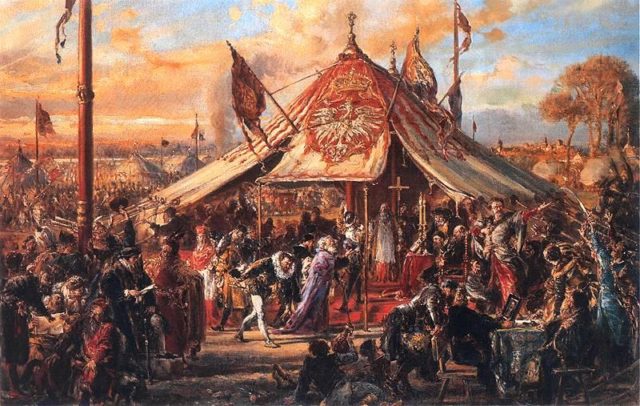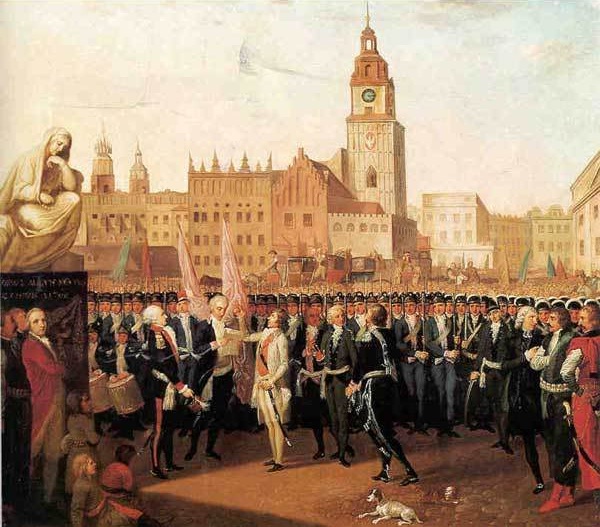Grown Up
In the 1560s under the threat of an increasing Russian Power, Sigismund II Augustus, presses for a complete union of the Kingdom of Poland & the Grand Duchy of Lithuania, achieving the formation of a federal state known as the Polish-Lithuanian Commonwealth in 1569.


In 1572 King Sigismund II the last of the Jagiellon kings dies childless & the throne passes to Henry III of Valois future King of France after he promises to marry Sigmund II’s sister Anna Jagiellon. It would be the beginning of a period of foreign-based rulers that would diminish Krakow’s role as a Polish power center. The beginning of the end of the golden era.


After Henry III of Valois became King of France in 1574 and since he hadn’t yet married Anna Jagiellon, the Parliament of the Polish-Lithuanian Commonwealth removed him from the seat of monarch & Anna Jagiellon, sister of the former King assumes the position with her new husband Stephen Báthory, Prince of Transylvania, after their crowning in Krakow in 1576.
With the death of her husband 10 years later & to maintain as much influence as possible, she proposes to the electors of the Parliament her nephew, Sigismund, the only son of her sister Catherine & John III of Sweden. Sigismund III of the Swedish house of Vasa, became King of the Polish-Lithuanian Commonwealth in 1587 marking the end of Krakow’s Golden Age.



The transfer of the administrative capital from Krakow to Warsaw in 1596, a major outbreak of the Bubonic plague, and a series of wars with Sweden, from 1598 to 1629 decimated the city’s population. The final blow came with the so-called Swedish Deluge (1655-1660) the invasion & occupation of the Commonwealth that would lead to the loss of 1/3 of its overall population, the pillaging of its big cities & the destruction of its status as a great European power.
 The end of the Swedish Deluge didn’t mean the end of warfare which was constant until 1720, mostly with Russia & the Ottoman Empire. That meant enormous population losses & massive damage to the economy & the social structure of both Krakow and Poland. Not everything was bleak however with the Polish Parliament adopting the first democratic constitution in Europe in 1791, just a few days after the first in the world in the United States of America.
The end of the Swedish Deluge didn’t mean the end of warfare which was constant until 1720, mostly with Russia & the Ottoman Empire. That meant enormous population losses & massive damage to the economy & the social structure of both Krakow and Poland. Not everything was bleak however with the Polish Parliament adopting the first democratic constitution in Europe in 1791, just a few days after the first in the world in the United States of America.
The democratic disposition of the Poles wouldn’t stop the three expanding powers of the era (Habsburg Austria, Kingdom of Prussia, and Russian Empire) from invading & dissecting the kingdom of Poland. In 1795 Krakow is incorporated into the Austrian province of Galicia despite the victorious battle of the Polish-Lithuanian army against a larger Russian army in the Battle of Racławice in April of 1794. The battle was followed by a failed insurrection against Prussia and Russia started by a speech in Krakow’s town square by the Polish freedom fighter veteran Tadeusz Kościuszko.


In 1809 Napoleon Bonaparte captures the Polish territories of the Habsburgs making Krakow part of the newly founded Duchy of Warsaw. Russian & Prussian troops took back control after the unsuccessful French invasion of Russia in 1812.
In 1815 the Congress of Vienna restores the prewar boundaries creating the partially independent Free city of Krakow. An uprising against Russia in 1830 leads to another full-scale Polish-Russian war, without the desired outcome. Despite the total abolition of the Polish constitution & army, Krakow manages to keep a form of independence as the Free City of Krakow or Republic of Krakow.



A new uprising in February of 1846, centered around the city of Krakow, proved to be another futile effort in the struggle for independence, ending with the annexation of the free city by the Austrian Empire as a part of the Kingdom of Galicia and Lodomeria in November of that same year.




